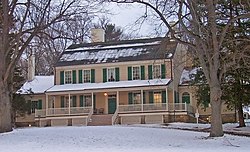The John Jay Homestead State Historic Site is located at 400 Jay Street in Katonah, New York. The site preserves the 1787 home of Founding Father and statesman John Jay (1745–1829), one of the three authors of The Federalist Papers and the first Chief Justice of the United States. The property was designated a National Historic Landmark in 1981 for its association with Jay. The house is open year-round for tours.
John Jay Homestead | |
 In 2007 | |
| Location | 400 Jay St., Katonah, NY |
|---|---|
| Coordinates | 41°15′1″N 73°39′31″W / 41.25028°N 73.65861°W |
| Area | 58.9 acres (23.8 ha) |
| Built | 1787–1790 |
| Architect | John Cooley and Moses Winian |
| Architectural style | Georgian |
| Website | www.JohnJayHomestead.org |
| NRHP reference No. | 72000918 |
| NYSRHP No. | 11901.000020 |
| Significant dates | |
| Added to NRHP | July 24, 1972[1] |
| Designated NHL | May 29, 1981[2] |
| Designated NYSRHP | June 23, 1980 |
Description and history
editThe John Jay Homestead is located in a rural setting east of the village of Katonah, on the north side of Jay Street (New York State Route 22). It is a 2+1⁄2-story gambrel-roofed brick building, with single-story gable-roofed wings to either side. The main facade is five bays wide, with sash windows arranged symmetrically around the centered entrance. The center bay is slightly wider than the others, and the entrance is topped by a four-light transom window. A shed-roof porch shelters the entire span of the first floor, wrapping around in open sections to secondary entrances in the side wings.[3]
The home was constructed in two major phases, on 600 acres (240 ha) of land that was part of a larger 5,200-acre (2,100 ha) parcel that his maternal grandfather Jacobus Van Cortlandt purchased from Chief Katonah around 1700.[4] John Jay made arrangements in February 1787 with brickmakers and carpenters for the first phase of construction, which was completed in 1790. The second phase, executed in 1800–01, included the extension of the main block to five bays and the addition of the wings (one replacing the first kitchen wing). Jay, whose long and illustrious career included the Continental Congress, drafting of New York's first state constitution, Governor of New York, and Chief Justice of both New York's Supreme Court and the United States Supreme Court, spent his retirement years on this property.[3]
The house remained in the Jay family until 1959, when it was given to Westchester County, which turned it over to the state. The state undertook the reversal of some alterations made after Jay's ownership, and opened it as a historic site.[3] In 1977, the non-profit Friends of John Jay Homestead was founded to increase public awareness of the site. It raises funds and provides volunteer assistance for the Homestead's preservation, restoration and interpretation.
The house was declared a National Historic Landmark in 1981.[2][3]
-
John Jay (Gilbert Stuart portrait, 1794)
-
South perspective view in 1961 (HABS)
Legacy
editIn 2004, the landmark, known as Bedford House, was added to the African American Heritage Trail of Westchester County, a group of 16 sites which include the Rye African-American Cemetery, Saint Paul's Church National Historic Site and the Jay Estate in Rye.[5]
See also
editReferences
edit- ^ "National Register Information System". National Register of Historic Places. National Park Service. January 23, 2007.
- ^ a b "John Jay Homestead". National Historic Landmark summary listing. National Park Service. September 15, 2007. Archived from the original on October 10, 2012.
- ^ a b c d Lynn A. Beebe (April 4, 1979). "National Register of Historic Places Inventory-Nomination: John Jay Homestead" (pdf). National Park Service.
{{cite journal}}: Cite journal requires|journal=(help) and Accompanying 30 photos, exterior, from 1979 and undated (6.22 MB) - ^ Magnet, Myron. The Founders at Home: The Building of America, 1735–1817. W. W. Norton, 2013, page 261.
- ^ "African American Heritage Trail brochure". Westchester County, New York. Retrieved December 17, 2021.
External links
edit- Media related to John Jay Homestead State Historic Site at Wikimedia Commons
- Official website
- Historic American Buildings Survey (HABS) No. NY-4393, "John Jay House, State Route 22, Katonah, Westchester County, NY", 16 photos, 2 color transparencies, 2 data pages

